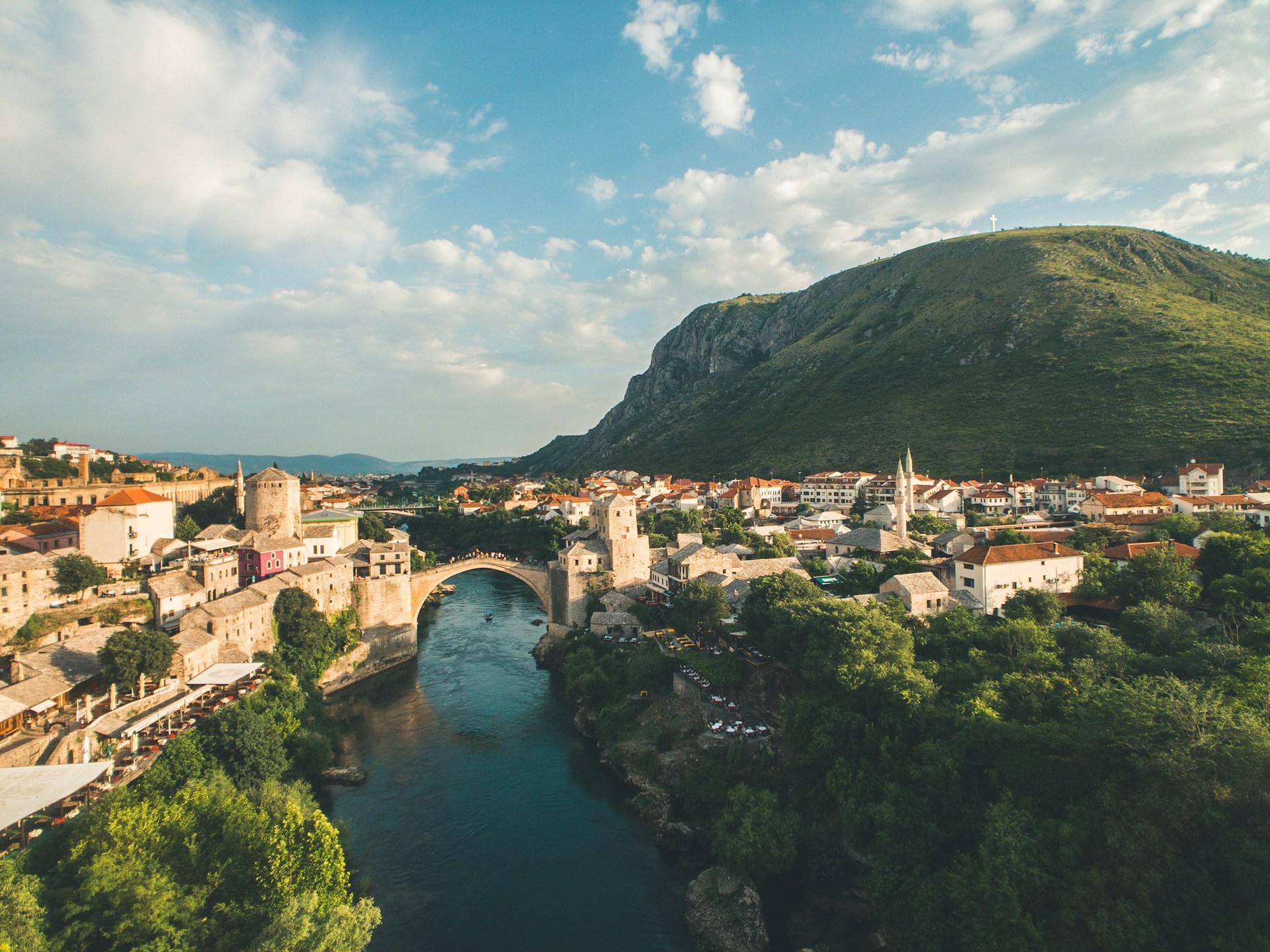Day 1 – Arrive Sarajevo
- Transfer from the airport and accommodation into the hotel,
- Dinner – pie,
- Free time
- Check-in hotel in Sarajevo.
Day 2 – Sarajevo – Mostar – Blagaj – Pocitelj – Kravice Waterfall – Mostar
- At the latest at 08:30 departure from the hotel,
- Coffee or tea break in a restaurant on the shores of Lake Jablanica
- 13:00 to 14:00 Blagaj tekke visits and lunch (portion trout, salad, drink)
- Accommodation in hotel in Mostar,
- Mostar free time,
- Dinner,
- Check-in hotel in Mostar.
The city of Mostar is unavoidable destination in Herzegovina, such as Blagaj and Počitelj, places located near to Mostar. Unspeakable source of the Buna river and mysterious Tekke, which is located at the source will not leave you indifferent, and the walls of Počitelj will make Herzegovina remain closed forever in your memories. Real gourmets should not miss this trip, as delicious trout from the river Neretva and lamb directly from the most beautiful pastures of Europe part of this tour.
Day 3 – Mostar
- Breakfast in hotel,
- Visit the old town Počitelj,
- Vsiting Kravice waterfalls,
- Lunch in Pocitelj
- Mostar City Tour (Visiting the Old Bridge)
- Mostar free time
- Dinner.
Kravica waterfall, often erroneously called Kravice, is a large tufa cascade on the Trebižat River, in the karstic heartland of Herzegovina in Bosnia and Herzegovina. It is 10 kilometres (6 mi) south of Ljubuški and 40 kilometres (25 mi) south of Mostar. Its height is about 25 metres (80 ft) and the radius of the lake in the base of the waterfall is 120 metres (390 ft)
After lunch we are back in Mostar.Mostar is a city located on the banks of the Neretva River and the largest city OF Herzegovina. The city is named after the bridge keepers Mostar and is one of the most beautiful cities in Bosnia and Hercegovini. The Old Bridge, a symbol of the city which was built in 1566, and in 2005, together with the old town was listed cultural heritage by UNESCO.Aslo we will visit Karadzoz-Begova mosque and Koski-Mehmet Pasina mosque.
Day 4 – Mostar – Sarajevo
- 09:00 Departure from the hotel,
- Visiting Jablanica II World War Museum
- Lunch on Jablanica Lake
- Going back to Sarajevo
- Visiting Vrelo Bosne Park
- Chek-in hotel Sarajevo
- Dinner – čevapčići
The Museum Battle for the Wounded on Neretva River is the museum located in the little town of Jablanica, in which the battle of Neretva River in the 2nd World War is explained. In this battle fought the partisans (iugoslavian army) and nazis. Here it is possible to see a lot of documents, objects, clothes and more things of soldiers of this battle. Moreover, you can see the bridge, which was destroyed in this battle. A very interesting place to people interested in the history.
Vrelo Bosne, in the municipality of Ilidža, is one of the country’s popular natural landmarks and provides a quiet escape from an otherwise busy city life. A Roman Bridge is located not far from Vrelo Bosne on the Bosna river in the Ilidža municipality, which was built sometime between 1530 and 1550 from the original Roman stones and ruins of the bridge that stood there during the Roman period used to connect the Romans with the village of Aquae Sulphurae at the time. Ilidža is also known to have been an archaeological site dating 2400–2000BC.
The spring water at Vrelo Bosne is drinkable, however not recommended. On a typical year more than 350,000 tourists visit the park.
Day 5 – Sarajevo – Travnik – Jajce
- 09:00 Departure from the hotel,
– Visiting Village Ahmici
- Travnik City Tour – visit castle and towers, mosques and madrassas,
- Coffee and baklava on the Plava Voda,
- 13:00 to 14:00 Lunch in a restaurant,
- Going to Jajce,
- 19: 00-20: 00 Dinner at Bosnian traditional restaurant,
- Check-in hotel in Sarajevo.
Ahmići is a village in central Bosnia and Herzegovina, located in the municipality of Vitez in the Lašva Valley.Ahmići massacre was the culmination of the Lašva Valley ethnic cleansing committed by the Croatian Community of Herzeg-Bosnia’s political and military leadership on Bosniak civilians during the Croat-Bosniak war in April 1993. It was the largest massacre committed during the conflict between Bosnian Croats and the Bosnian government (dominated by Bosniaks).
The capital of the Ottoman vizier or vizier town, as it is still called the inevitable destination in Central Bosni. 90 km distance is the town of Travnik from the capital of our country in spite of its beauty it is one of the reasons why Travnik highly visited place. On the way to Travnik required in one direction draws in Kiseljak and drinking mineral water from the tap, and in the other direction to ride the latestway to Sarajevo. In addition to the distinctive chicken on the spit there is the famous Travnik baklava and coffe.
Jajce is an increasingly attractive destination in Central Bosnia, and is located at the confluence of the Pliva and the Vrbas river. It is known for its waterfall and old town. It is a place that will be forever remembered and will be happy and come back to it. Distance Jajce from Sarajevo 138 km. In this one-day trip included a brief visit to Travnik.
Day 6 – Sarajevo
- At the latest at 09:30 departure from the hotel,
- Visiting the Tunnel of Hope,
- City Tour (Bascarsija – Sebilj, Moric han, Bey’s Mosque and madrasas, Bezistan, Ferhadija street, Cathedral, market place Markale, Eternal Flame, The Orthodox Church, Tašlihan, Princip bridge, Atmejdan, Emperor – Fatih mosque, Inat Kuća and City Hall)
- Lunch in traditional restoran at Bascarsija
- Free time
- Hotel Chek-in
The Sarajevo Tunnel (Bosnian: Tunel spasa) was an underground tunnel constructed between March and June of 1993 during the Siege of Sarajevo in the midst of the Bosnian War. It was built by the Bosnian Army in order to link the city of Sarajevo, which was entirely cut off by Serbian forces, with Bosnian-held territory on the other side of the Sarajevo Airport, an area controlled by the United Nations. The tunnel linked the Sarajevo neighbourhoods of Dobrinja and Butmir, allowing food, war supplies, and humanitarian aid to come into the city, and allowing people to get out. The tunnel became a major way of bypassing the international arms embargo and providing the city defenders with weaponry.
Sarajevo (names in other languages) is the capital and largest city of Bosnia and Herzegovina, with a population of 275,524. The Sarajevo metropolitan area, including Sarajevo, East Sarajevo and surrounding municipalities, is home to 466,000 inhabitants. Moreover, it is also the capital of the Federation of Bosnia and Herzegovina entity, and the center of the Sarajevo Canton. Nestled within the greater Sarajevo valley of Bosnia, it is surrounded by the Dinaric Alps and situated along the Miljacka River in the heart of Southeastern Europe and the Balkans.
Sarajevo is the leading political, social and cultural center of Bosnia and Herzegovina, a prominent center of culture in the Balkans, with its region-wide influence in entertainment, media, fashion, and the arts.
Due to its long and rich history of religious and cultural variety, Sarajevo is sometimes called the “Jerusalem of Europe” or “Jerusalem of the Balkans”. It was, until late in the 20th century, the only major European city to have a mosque, Catholic church, Orthodox church and synagogue within the same neighborhood. A regional center in education, the city is also home to the Balkans’ first institution of tertiary education in the form of an Islamic polytechnic called the Saraybosna Osmanlı Medrese, today part of the University of Sarajevo.
Although settlement in the area stretches back to prehistoric times, the modern city arose as an Ottoman stronghold in the 15th century. Sarajevo has attracted international attention several times throughout its history. In 1885, Sarajevo was the first city in Europe and the second city in the world to have a full-time electric tram network running through the city, following San Francisco. In 1914, it was the site of the assassination of the Archduke of Austria that sparked World War I. In WWII, Sarajevo was part of Ustashe’s Independent State of Croatia, where many Serbs and Jews were killed. Forty years later, it hosted the 1984 Winter Olympics. For nearly four years, from 1992 to 1996, the city suffered the longest siege of a city in the history of modern warfare (1,425 days long) during the Bosnian War.
Sarajevo has been undergoing post-war reconstruction, and is the fastest growing city in Bosnia and Herzegovina.The travel guide series, Lonely Planet, has named Sarajevo as the 43rd best city in the world, and in December 2009 listed Sarajevo as one of the top ten cities to visit in 2010.In 2011, Sarajevo was nominated to be the European Capital of Culture in 2014 and will be hosting the European Youth Olympic Festival in 2019.
Sarajevo is also a metropolis due to being the most important and influential city in the whole country.
Day 7 – Depart Sarajevo
- Chek out from the hotel (at the latest at 11:00),
- Transfer to the airport.
Services that are included in the package:
- Accomodation in a 3, 4 or 5 stars hotel in a twin or dbl rooms,
- Food (3 meals a day, every day)
- Professional licensed guide,
- Transport in a exclusive busses,
- City tours and
- Museums visits.
Services that are not included in the package:
- Flight ticket,
- Extra consumption and shoping,
- Hotel extras.

